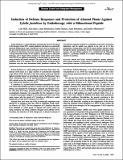Por favor, use este identificador para citar o enlazar a este item:
http://hdl.handle.net/10261/310024COMPARTIR / EXPORTAR:
 SHARE SHARE
 CORE
BASE CORE
BASE
|
|
| Visualizar otros formatos: MARC | Dublin Core | RDF | ORE | MODS | METS | DIDL | DATACITE | |

| Título: | Induction of Defense Responses and Protection of Almond Plants Against Xylella fastidiosa by Endotherapy with a Bifunctional Peptide |
Autor: | Moll, Luís; Baró, Aina; Montesinos, Laura; Badosa, Esther; Bonaterra, Anna; Montesinos, Emilio | Palabras clave: | Transcriptomic response Prunus dulcis Xylella fastidiosa Almond leaf scorch Bacterial pathogens Defense pathways Plant immune responses Synthetic antimicrobial peptides |
Fecha de publicación: | sep-2022 | Editor: | American Phytopathological Society | Citación: | Phytopathology 112(9): 1907-1916 (2022) | Resumen: | Xylella fastidiosa is a plant pathogenic bacterium that has been introduced in the European Union (EU), causing significant yield losses in economically important Mediterranean crops. Almond leaf scorch (ALS) is currently one of the most relevant diseases observed in Spain, and no cure has been found to be effective for this disease. In previous reports, the peptide BP178 has shown a strong bactericidal activity in vitro against X. fastidiosa and to other plant pathogens, and to trigger defense responses in tomato plants. In the present work, BP178 was applied by endotherapy to almond plants of cultivar Avijor using preventive and curative strategies. The capacity of BP178 to reduce the population levels of X. fastidiosa and to decrease disease symptoms and its persistence over time were demonstrated under greenhouse conditions. The most effective treatment consisted of a combination of preventive and curative applications, and the peptide was detected in the stem up to 60 days posttreatment. Priming plants with BP178 induced defense responses mainly through the salicylic acid pathway, but also overexpressed some genes of the jasmonic acid and ethylene pathways. It is concluded that the bifunctional peptide is a promising candidate to be further developed to manage ALS caused by X. fastidiosa.[Formula: see text] Copyright © 2022 The Author(s). This is an open access article distributed under the CC BY-NC-ND 4.0 International license. | Descripción: | Beyond Xylella, Integrated Management Strategies for Mitigating Xylella fastidiosa Impact in Europe (BeXyl) (Grant Agreement 101060593). Partner/Coordinador principal: Blanca B. Landa del Castillo, Investigadora Científica del Instituto de Agricultura Sostenible (IAS-CSIC). | Versión del editor: | https://doi.org/10.1094/PHYTO-12-21-0525-R | URI: | http://hdl.handle.net/10261/310024 | DOI: | 10.1094/PHYTO-12-21-0525-R | ISSN: | 0031-949X | E-ISSN: | 1943-7684 |
| Aparece en las colecciones: | (IAS) Artículos |
Ficheros en este ítem:
| Fichero | Descripción | Tamaño | Formato | |
|---|---|---|---|---|
| Bifunctional-Peptide.pdf | 1,02 MB | Adobe PDF |  Visualizar/Abrir |
CORE Recommender
PubMed Central
Citations
7
checked on 04-may-2024
SCOPUSTM
Citations
8
checked on 14-may-2024
WEB OF SCIENCETM
Citations
7
checked on 27-feb-2024
Page view(s)
36
checked on 16-may-2024
Download(s)
11
checked on 16-may-2024

